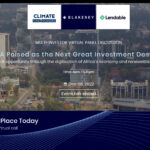Introduction
In 2022, the impact investing sector continued to grow, becoming a major force in the global financial market. The growth in impact investing has been attributed to a growing focus on environmental, social, and governance (ESG) factors across a wider section of the investment community.
According to GIIN’s 2020 survey, the global impact investing market was estimated to be worth $715 billion, however by 2022 the GIIN’s latest estimates had the market pegged at around USD1.16Tr[i].
Pretty significant growth. This milestone was announced at the GIIN Conference in The Hague in October to huge fanfare. The celebrations were worthy, especially for those GIIN members who have been working on impact investing for many years. However a Trillion US Dollars in total assets remains many trillions short of the mark when it comes to solving the world’s biggest problems through capital investments.
The OECD estimates the SDG financing gap (i.e. the difference between the estimated amount of money needed to achieve the Sustainable Development Goals (SDGs) and the actual amount of money currently available) as $4 trillion USD annually[ii]. Whilst many massive global investors have embraced the SDGs[iii] the actual flow of capital into impact strategies falls woefully short of solving these problems.
Many point to the growth of ESG investments as a tool to solve the world’s big problems. But whilst the “theme” of ESG continues to grow it’s worth re-iterating that “Impact Investing” and ESG are not the same.
Impact investing is more focused on achieving a specific goal, such as reducing carbon emissions or increasing access to financial services (and is often directly linked to the SDGs), while ESG investing is more broad-based, looking at a company’s overall management of core environmental and societal risks and implementing better governance.
In publicly markets investing, ESG has in many cases been simplified to a score or rating or more widely as risk management on a portfolio wide basis. Whilst impact investing seeks to address the intention of the investment to contribute to measurable social or environmental benefit and to track and improve that contribution over time.
There are many signs of optimism to indicate an increased flow of intentional impact capital. The total number of impact investment firms also grew, with an estimated 1,340 investors worldwide. These funds were often supported by institutional investors, such as banks, pension funds, and insurance companies. Big name fund managers are entering the impact fray, with many global brands having launched or working on large launches. Boutique funds however, remain the mainstay of the market, with long track records and expertise but seemingly a lack of institutional capital backers[iv].
2022 has seen an increased interest from large investment managers in impact investing. This clearly demonstrates the potential of impact investing to drive systemic change and generate positive outcomes at scale, however many in the impact community question the bona fides of large organisations and questions on greenwashing[v] and impact or “purpose-washing” are never far away[vi]. Moreover the wider activities of large asset management firms can include investments that are arguably detrimental for society and/or the planet. For some large firms, their portfolios include weapons companies, polluters, companies engaged in deforestation and displacement of communities and even the use of slave labour[vii].
Closer to our home in Australia, deployment of capital to impact investments has been few and far between. Encouragingly there has been a significant upturn in interest amongst investors but market volatility has played havoc with portfolios.
Moreover super funds are increasingly constrained by Your Future Your Super benchmarks that “kneecap”[viii] sustainable investing and fee requirements that favour very large fund managers with the ability to scale (or apply resources to creatively “structure” or obfuscate manager fees).
The pressure is on super funds to find a way to satisfy the growing demand for impact amongst their client base without resorting to “greenwashing”. With the Securities regulator putting the market on notice for greenwashing action, it’s almost a no-win situation for many participants.
Outside of Australia, unconstrained investors dominate the global institutional landscape. Dutch pension funds (widely regarded as amongst global leaders in investing) have allocated (on average) 10% to Impact Managers with around EUR76bn at risk in impact funds[ix].
Emerging markets is another area that is closely aligned with impact. We see underrepresentation of emerging markets in Australian portfolios. Elsewhere Canadian Pensions (again seen as global leaders) have material emerging market investments with CCPIB (one of the largest) having one quarter of all fund investments (CAD120bn) invested in emerging markets.
In this (our inaugural) Impact Insights, the Wealth of Nations Impact Asset Management team will cover off on our key learning and insight gained in 2022, delve into three case studies across Renewable Energy, private lending and take a deep dive on Africa.
We hope you find these insights useful and we are always open to feedback and conversations!
Report Coverage
- Introduction
- Our insights
- Performance commentary
- Impact Report
- Credit Case Study: Fintech
- PE Case Study: Green Data Centres
- EM Case Study: Africa
- 2023 – looking forward
Want to take a deep dive into our IMPACT INSIGHTS Report, click the subscribe button below and we will send the report once it’s hot off the press in January.
TEAM WON-IAM.
[i] GIINsight: Sizing the Impact Investment Market: October 2022
https://thegiin.org/asset/Sizing%20the%20Impact%20Investing%20Market_webfile.pdf
[ii] https://www.oecd.org/dev/OECD-UNDP-Scoping-Note-Closing-SDG-Financing-Gap-COVID-19-era.pdf
[iii] https://www.gisdalliance.org/about
[iv] GIINsight: Sizing the Impact Investing Market
[v] https://www.forbes.com/advisor/investing/greenwashing-esg/
[vi] Findlay, Suzanne & Moran, Michael. (2018). Purpose-washing of impact investing funds: motivations, occurrence and prevention. Social Responsibility Journal. 15. 10.1108/SRJ-11-2017-0260.
[viii] https://ioandc.com/yfys-kneecaps-climate-investing-needs-new-benchmarks-riaa/
[ix] https://impact-investor.com/nab-netherlands-punching-below-its-weight-in-contributing-to-sdgs/










![Annnual Insights Report Popup[16]](https://www.wealthofnationsiam.com.au/wp-content/uploads/2023/01/Annnual-Insights-Report-Popup16.png)